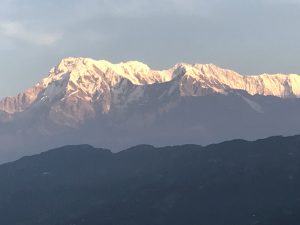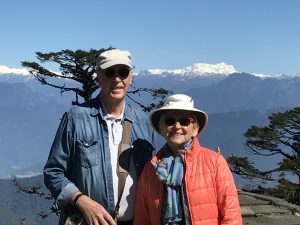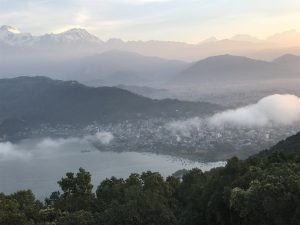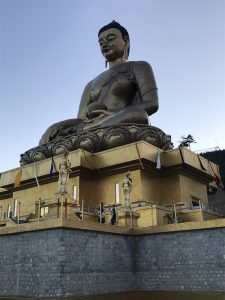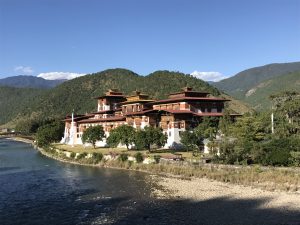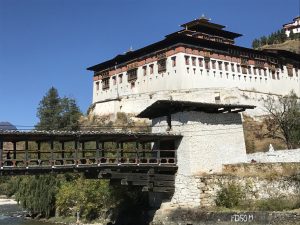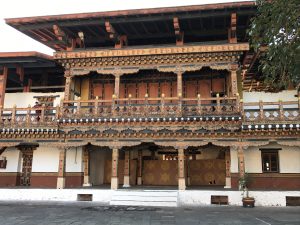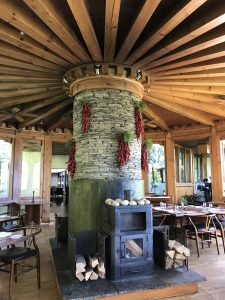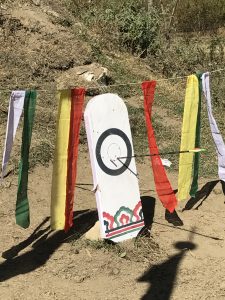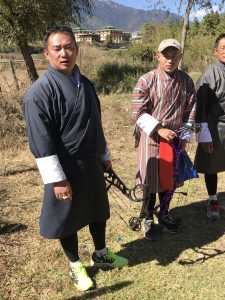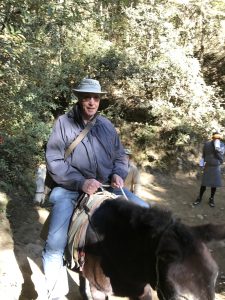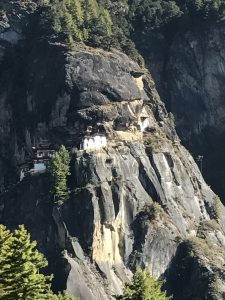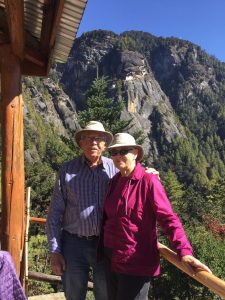The land of Gross National Happiness
If you do not read the entire blog suggest you go to the last part describing the dark side of Bhutan
In November 2017 we visited the Himalayan Kingdoms of Bhutan and Nepal. Or rather former Kingdoms. I had high expectations for the visit but my expectations were exceeded in both countries. Yet there is a dark underside.
- Himalayas are spectacular
Bhutan is perceived as remote, difficult to access, somehow still living in a prior age, strangely exotic and exceedingly beautiful. These descriptions all have a large measure of truth but it is also a small country that has defied many of the dominant and destructive values and practices of our world and is creating its own path to a sustainable, modern and more just future.
Bhutan has pioneered the concept of Gross National Happiness as a way of stating that economic metrics must be balanced with other metrics that place a value on access to education and health, a sustainable environment, protection of its incredible biodiversity and more. Bhutan is the first country to be not only carbon neutral but carbon negative and in spite of that achievement is promoting electric cars. Bhutan is the first country in the world to completely outlaw smoking.
Located in the eastern Himalayas, its physical isolation has allowed Bhutan to preserve its independence in a neighborhood of large and aggressive countries. Its list of neighbors read like a tale from the Arabian nights – Sikkim, Assam, Tibet. Bhutan is host to the second highest mountain in the world and the highest unclimbed peak – easier to accomplish if it is illegal to climb sacred mountains!
Bhutan emerged from self-imposed isolation only 50 years ago and made several strategic decisions. It is a Buddhist country and supports and promotes its Buddhist heritage although officially there is freedom of religion. We understood that contradiction to mean that it Is illegal to proselytize but if a person decides to practice another faith it is legal to do so publicly. Television and the Internet are viewed with suspicion in terms of their influence and permitted only very recently. Homosexual acts are illegal. There are many contradictions!
The local language is a collection of Tibetan dialects with few written materials. The country made a strategic and bold decision that all school instruction from first grade would be in the English language – and the English accent is very neutral when considered on a global scale. This makes Bhutan and its people feel much more accessible as a tourist when every child and market seller can converse comfortably in English. It is great for tourism and also results in greater ability for Bhutanese to study internationally.
Bhutan entered the world of tourism much later than other countries and could make strategic decisions that would be difficult in any place that is more accessible. Tourists other than from India and Bangladesh are required to visit in the care of a tourist agency and spend a minimum of US$250 per person per day. This keeps out the backpackers and the former Kathmandu crowd looking for a cheap chemical high. As a consequence, all facilities are three-star and higher with spectacular choices at the top end. There are an amazing 5 Aman resorts in Bhutan – the ultimate in exotic travel.
- Billed as the largest Buddha statue in the World. Brand new and plenty of gold.
- The stupas and other Buddhist monuments are everywhere, well maintained and stunning in their beauty.
Arriving in Bhutan is an adventure in its own right. The Paro airport is rated as one of the most difficult places to land in the world and we were told that there were either 17 or 26 pilots in the world authorized to land in Paro. We landed on a clear day and watched the pilot skirt the tops of ridges and cling to sides of valleys as he threaded the needle to an eventual safe landing.
- Two of the historic Dzongs or fortresses. Combination of defense, administration and Buddhist temple.
There are currently 100,000 tourist arrivals per year which leaves even the most popular venues relatively uncrowded. There are several must-visit sights but the Tiger’s Nest monastery at the end of several challenging hours of hiking and at an altitude of 10,000 feet is at the head of any list. Between my legs and lungs I made it to the tearoom at 9,000 feet and enjoyed the view.
Bhutan has a population of 760,000 and an annual GDP of $3,000. With free critical services such as health and education, plenty of physical space and clean air the country feels much more prosperous than that number would indicate. The architecture is exquisite and the mandatory white and brown structures look like the Austrian Alps with Buddhist and Tibetan designs.
The limited population and small tourist numbers makes movement around the country comfortable but also spectacular since you are forever driving at the edge of a cliff with the imposing Himalayas as a permanent backdrop.
I had the privilege of celebrating my 75th birthday in Bhutan. We honored the occasion with a sort of communal bath using hot rocks to heat the water followed by a cultural performance and local dinner in a farmhouse high up in the hills – a great way to celebrate a big number.
Bhutan has been influenced or ruled by groups originating in Tibet. It adopted Buddhism of the Tibetan variety in the 7th century and the country is officially Buddhist. It is now also a constitutional monarchy. The King abdicated his role as King and introduced a new constitution in 2005. He then appointed his younger son – who now becomes a constitutional monarch and lives modestly with his commoner wife.
As I stated at the beginning – there is also a dark side.
Bhutan until recently included a population known as the Lhotshampa. They speak a version of Nepali and are a group that migrated into Bhutan since the late 1800’s. They are predominantly Hindu, have different cultural practices and speak a different language. Presumably they are migrants from the region of Nepal. Bhutan decided that cultural homogeneity (enforced language and dress code among other restrictions) was important and in the 1990’s made the decision to pressure the Lhotshampa to leave. Those who did not so voluntarily were forcefully evicted. Many were arrested and had their property confiscated. Nepal did not want them back (and went to great length to assure that they or their descendants could not become Nepali citizens) and many continue to languish in refugee camps. A significant number have been resettled in third countries.
Different reports estimate that they had represented from 20-45% of the population of Bhutan so this was not a minor event but ethnic cleansing on a grand scale. The numbers pushed out of Bhutan are estimated in the several hundred thousand. The rationale within Bhutan was that this sizable population would not or could not integrate into the perceived Buddhist/Tibetan essence of the nation and as the country moved toward democracy would be able to electorally alter its character.
If we replace Bhutan with Rakhine, the Lhotshampa with Rohingya, replace Hindu with Muslim and consider differences of language, and culture – this event is almost identical to Myanmar and Rakhine of today. The Rohingya minority represents approximately one third of the population of Rakhine and given historic and regional experience is predictably unlikely to want to or be able to integrate in terms of religion, language or culture. In the current self-perception of all groups in Myanmar – ethnicity, territory and citizenship are aligned. We should not be so surprised.
It is notable that the remoteness of Bhutan somehow prevented this rather severe ethnic cleansing from having the same international impact as the Rohingya problem. Possibly the 24-hour news cycle and the insatiable appetite for photos and stories was less advanced. Possibly it was simply physical isolation. Before we moralize too much consider the alignment between ethnicity and politics closer to home. In Canada it is Quebec. The USA struggles with the diminishing role of its white population. Belgium has the Walloons and eastern Europe and the Balkans face many struggles – and then we get to Israel, the Middle East and the tribal and religious challenges of Africa.
Bhutan is a cultural, geographic and environmental Shangri-la. Put it high up on your bucket list of places to visit. Enjoy its beauty and wonderful people but remember that imperfection lies close to all of us.
- We could spin the wheels for prayer but not sure of the message being sent.
- Color is in fashion. Note the skirts which are part of the cultural dress for women are worn under almost all conditions.
- Cultural program to celebrate turning 75!
- Archery is the national sport of Bhutan. To understand that arrow inside a 10 inch bullseye – it was shot from 145 meters!!!
- The archer has a very modern bow and is wearing the national dress for men.


